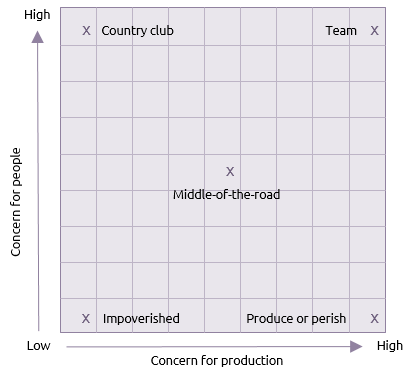Robert Blake and Jane Mouton developed their managerial grid in the early 1960’s1. They described two dimensions:
-
concern for people indicates the degree to which a leader considers team members’ needs, interests and personal development.
- concern for production indicates the degree to which the leader emphasises objectives, organisational efficiency and productivity.
Within these dimensions they identified five example managerial styles:

-
Impoverished
An impoverished leader is largely ineffective. They are not particularly interested in developing systems or people. In fact they aren’t especially interested in getting a job done – not really a leader at all. -
Country club
A country club leader is primarily focused on people and assumes that if they are happy and secure, they will work hard and achieve the objectives. This style of leadership can result in poor results due to a lack of direction and control. -
Produce or perish
This type of leader is authoritative and similar to McGregor’s theory X. They focus on efficient procedures and employee needs are always secondary to the production of the objectives. -
Team leadership
A manager with this style places equal emphasis on both people and production. To paraphrase Blake and Mouton for the P3 environment - they believe that if people understand the objectives, their role in achieving the end benefits and are involved in determining the means of achieving those benefits, then their needs and production needs will coincide.Blake and Mouton saw this as the best managerial style although models such as Hersey and Blanchard show that one managerial style doesn’t fit all situations. This style is similar to McGregor’s theory Y.
-
Middle-of-the-road
While this may appear to be a useful compromise situation between people and production it often means that the manager is happy with average performance and neither the needs of people nor the needs of production are fully met.
The managerial grid has been used as the basis for many other models such as Hersey and Blanchard and Thomas-Kilmann. From a P3 manager’s point of view all these models must be interpreted according to the context of a project or programme, the way a team develops (e.g. Tuckman), the life cycle phase being led and the general capability maturity of the host organisation.
- Blake R, Mouton J (1964), The Managerial Grid, Gulf Publishing, Houston.





